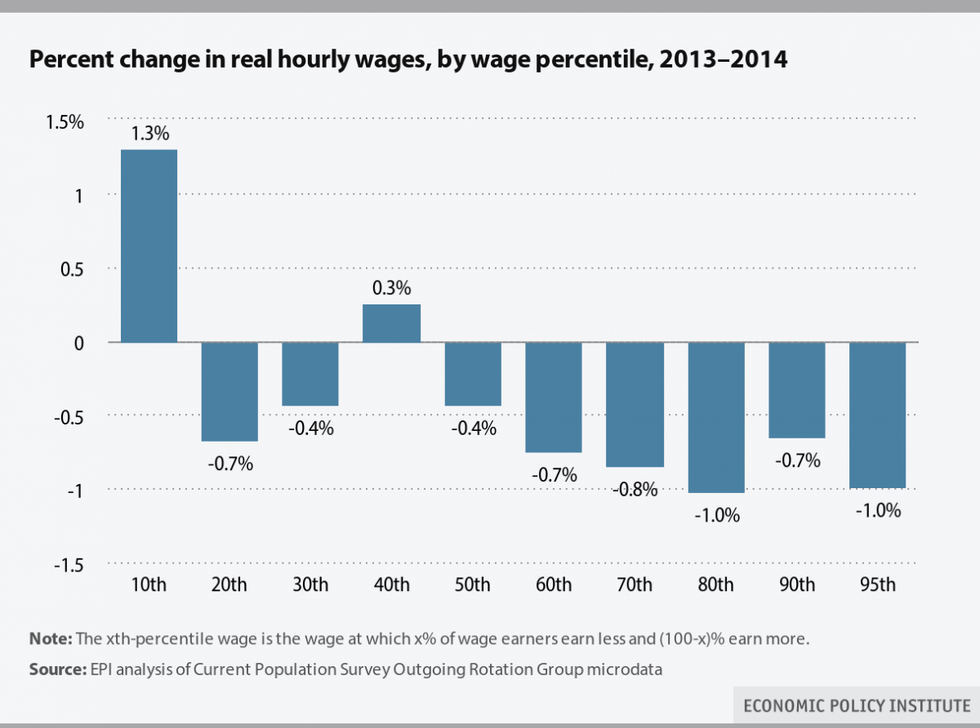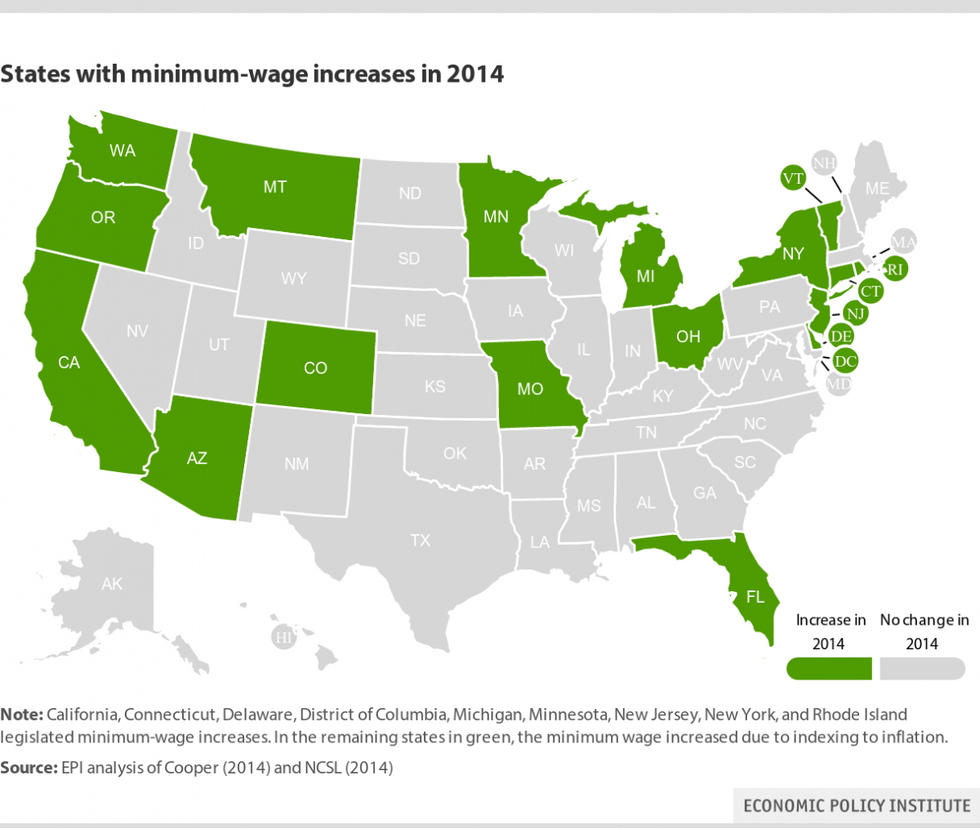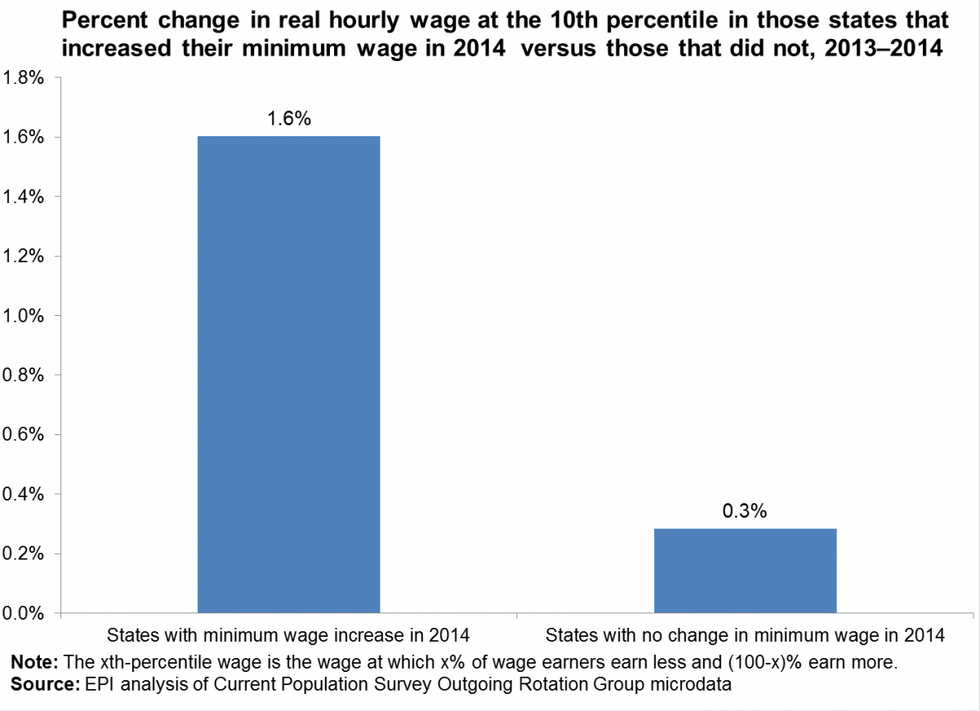

SUBSCRIBE TO OUR FREE NEWSLETTER
Daily news & progressive opinion—funded by the people, not the corporations—delivered straight to your inbox.
5
#000000
#FFFFFF
To donate by check, phone, or other method, see our More Ways to Give page.


Daily news & progressive opinion—funded by the people, not the corporations—delivered straight to your inbox.
In a report released this week, I found that 2014 continued a 35-year trend of broad-based wage stagnation. Real, inflation-adjusted hourly wages stagnated or fell across the board, with one notable, glimmer of positive news: Unlike the rest of the wage distribution, wages actually increased at the 10th percentile between 2013 and 2014.
The figure below shows changes in real hourly wages throughout the wage distribution between 2013 and 2014. What is particularly striking is that almost every decile and the 95th percentile experienced real wage declines from 2013 to 2014, with two exceptions. First, there was a very small increase at the 40th percentile wage, up 3 cents, or 0.3 percent. But a more economically significant increase occurred at the 10th percentile where hourly wages were up 11 cents, or 1.3 percent.

So, why did wages at the bottom tick up when they fell for nearly everyone else? What is so special about that wage that sits below 90 percent and above 10 percent of workers (i.e., is not generally earned by particularly privileged workers)?
The answer is simple: we still have some labor standards that provide wage protections. More specifically, 18 states increased their minimum wage in 2014 (either through legislation or through automatic inflation adjustments). The states with minimum wage increases in 2014, displayed in green below, represent 57 percent of the workforce.

When we compare states with and without a minimum wage increase, we find clear evidence that the minimum wage is the reason people at the 10th percentile wage didn't see the negative trends found elsewhere in the workforce. The figure below compares the wages in these states with those in states without minimum wage increases. Wages at the 10th percentile rose by 1.6% in states with minimum wage increases, while in states without such an increase, they pretty much stagnated--increasing by a scant 0.3%.

The great news in this story is that policy can actually affect the labor market. And, it is imperative that we use all the policy levers at our disposal to help rejuvenate the economy, create jobs, and build stronger wage and income growth for the 99%.
Dear Common Dreams reader, The U.S. is on a fast track to authoritarianism like nothing I've ever seen. Meanwhile, corporate news outlets are utterly capitulating to Trump, twisting their coverage to avoid drawing his ire while lining up to stuff cash in his pockets. That's why I believe that Common Dreams is doing the best and most consequential reporting that we've ever done. Our small but mighty team is a progressive reporting powerhouse, covering the news every day that the corporate media never will. Our mission has always been simple: To inform. To inspire. And to ignite change for the common good. Now here's the key piece that I want all our readers to understand: None of this would be possible without your financial support. That's not just some fundraising cliche. It's the absolute and literal truth. We don't accept corporate advertising and never will. We don't have a paywall because we don't think people should be blocked from critical news based on their ability to pay. Everything we do is funded by the donations of readers like you. Will you donate now to help power the nonprofit, independent reporting of Common Dreams? Thank you for being a vital member of our community. Together, we can keep independent journalism alive when it’s needed most. - Craig Brown, Co-founder |
In a report released this week, I found that 2014 continued a 35-year trend of broad-based wage stagnation. Real, inflation-adjusted hourly wages stagnated or fell across the board, with one notable, glimmer of positive news: Unlike the rest of the wage distribution, wages actually increased at the 10th percentile between 2013 and 2014.
The figure below shows changes in real hourly wages throughout the wage distribution between 2013 and 2014. What is particularly striking is that almost every decile and the 95th percentile experienced real wage declines from 2013 to 2014, with two exceptions. First, there was a very small increase at the 40th percentile wage, up 3 cents, or 0.3 percent. But a more economically significant increase occurred at the 10th percentile where hourly wages were up 11 cents, or 1.3 percent.

So, why did wages at the bottom tick up when they fell for nearly everyone else? What is so special about that wage that sits below 90 percent and above 10 percent of workers (i.e., is not generally earned by particularly privileged workers)?
The answer is simple: we still have some labor standards that provide wage protections. More specifically, 18 states increased their minimum wage in 2014 (either through legislation or through automatic inflation adjustments). The states with minimum wage increases in 2014, displayed in green below, represent 57 percent of the workforce.

When we compare states with and without a minimum wage increase, we find clear evidence that the minimum wage is the reason people at the 10th percentile wage didn't see the negative trends found elsewhere in the workforce. The figure below compares the wages in these states with those in states without minimum wage increases. Wages at the 10th percentile rose by 1.6% in states with minimum wage increases, while in states without such an increase, they pretty much stagnated--increasing by a scant 0.3%.

The great news in this story is that policy can actually affect the labor market. And, it is imperative that we use all the policy levers at our disposal to help rejuvenate the economy, create jobs, and build stronger wage and income growth for the 99%.
In a report released this week, I found that 2014 continued a 35-year trend of broad-based wage stagnation. Real, inflation-adjusted hourly wages stagnated or fell across the board, with one notable, glimmer of positive news: Unlike the rest of the wage distribution, wages actually increased at the 10th percentile between 2013 and 2014.
The figure below shows changes in real hourly wages throughout the wage distribution between 2013 and 2014. What is particularly striking is that almost every decile and the 95th percentile experienced real wage declines from 2013 to 2014, with two exceptions. First, there was a very small increase at the 40th percentile wage, up 3 cents, or 0.3 percent. But a more economically significant increase occurred at the 10th percentile where hourly wages were up 11 cents, or 1.3 percent.

So, why did wages at the bottom tick up when they fell for nearly everyone else? What is so special about that wage that sits below 90 percent and above 10 percent of workers (i.e., is not generally earned by particularly privileged workers)?
The answer is simple: we still have some labor standards that provide wage protections. More specifically, 18 states increased their minimum wage in 2014 (either through legislation or through automatic inflation adjustments). The states with minimum wage increases in 2014, displayed in green below, represent 57 percent of the workforce.

When we compare states with and without a minimum wage increase, we find clear evidence that the minimum wage is the reason people at the 10th percentile wage didn't see the negative trends found elsewhere in the workforce. The figure below compares the wages in these states with those in states without minimum wage increases. Wages at the 10th percentile rose by 1.6% in states with minimum wage increases, while in states without such an increase, they pretty much stagnated--increasing by a scant 0.3%.

The great news in this story is that policy can actually affect the labor market. And, it is imperative that we use all the policy levers at our disposal to help rejuvenate the economy, create jobs, and build stronger wage and income growth for the 99%.